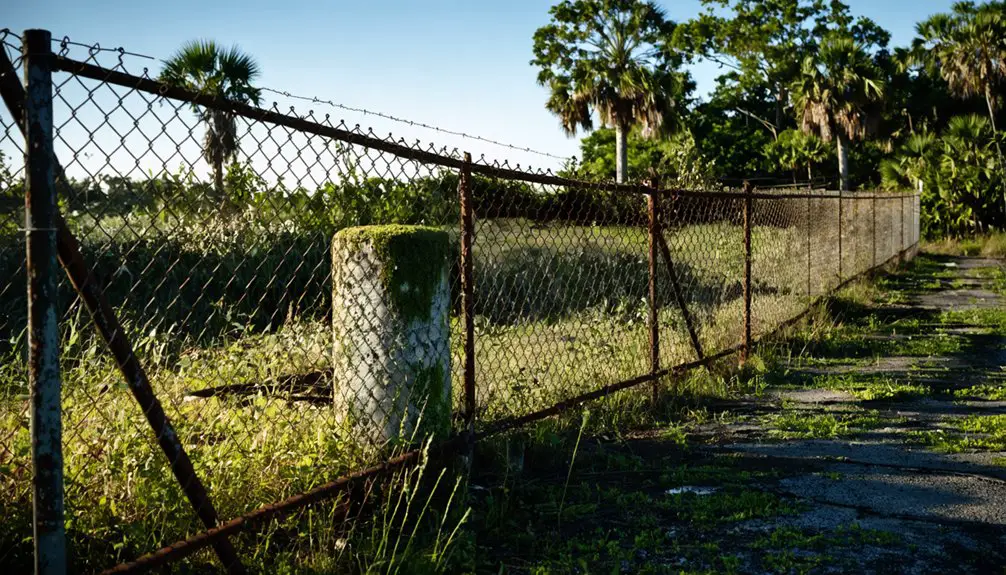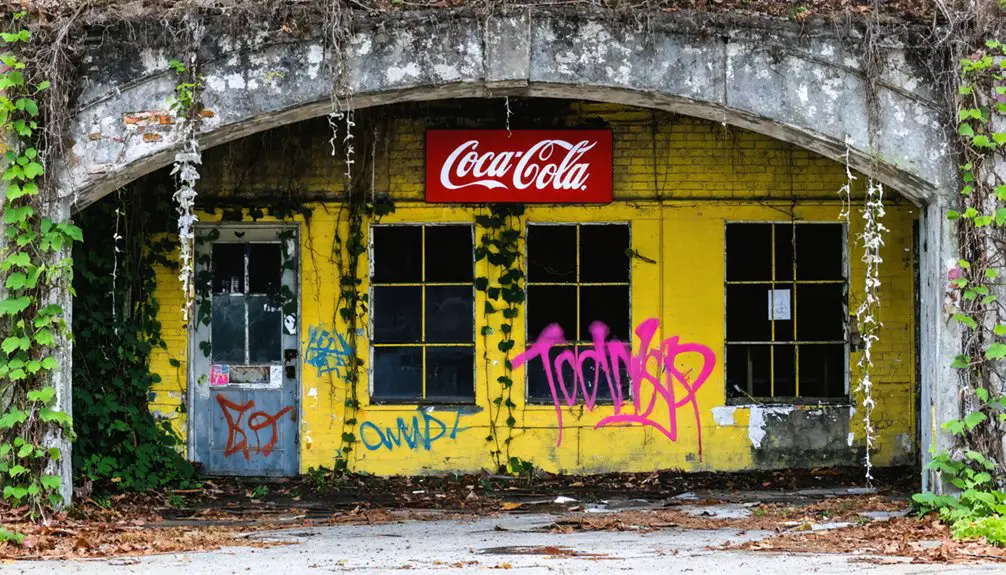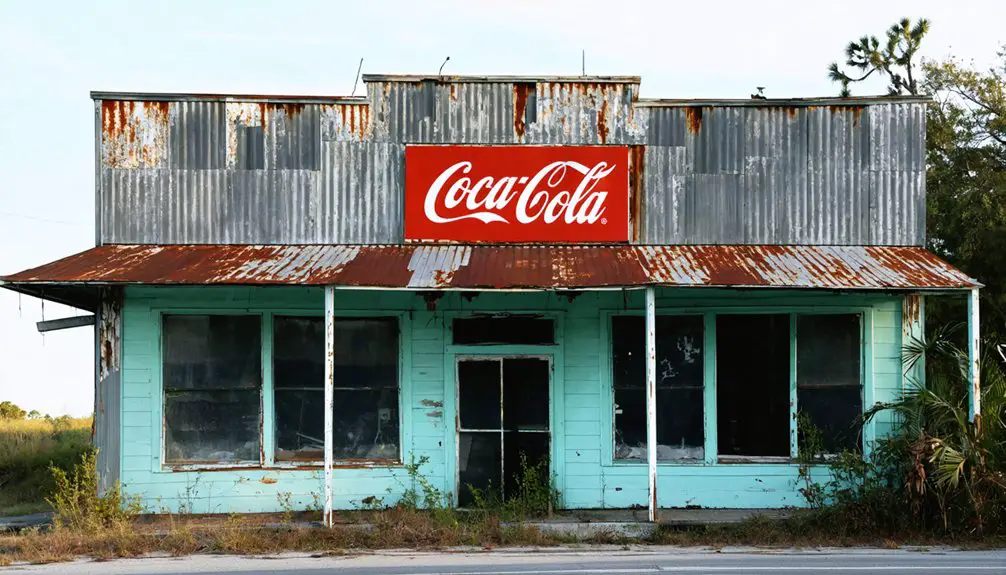You won’t find Apix, Florida on modern maps, but during the Cold War, this phantom town appeared as a planned community of 7,000 homes in Palm Beach County’s swamplands. In reality, it served as an elaborate government deception to hide classified military research into hydrogen-powered rockets and Nike missiles. The only visible structure was a general feed store, while the rest existed purely on paper. The true story of Apix reveals one of America’s most sophisticated military cover operations.
Key Takeaways
- Apix was a fabricated Florida town created in the 1950s to conceal classified military operations focused on hydrogen-powered rocket engines.
- The phantom town existed primarily on paper with planned infrastructure for 7,000 homes but only had a single feed store.
- Military deception included mock agricultural buildings hiding Nike missile installations and spy plane facilities during the Cold War.
- Government agencies created false census data, maps, and planning documents to maintain the illusion of a legitimate community.
- No physical remnants of the ghost town exist today, except for scattered industrial testing sites from Pratt & Whitney operations.
The Birth of a Phantom Town
While many American towns emerged organically through settlement and growth, Apix, Florida came into existence purely as a government fabrication in the late 1950s.
Unlike most towns born from natural expansion, Apix was an elaborate government illusion created to hide military secrets.
Its phantom origins were carefully orchestrated to conceal a classified military installation focused on experimental hydrogen-powered rocket engines.
You’ll find that Apix’s fictional infrastructure was meticulously planned on paper, with plots for 7,000 homes and a cover story centered around a fertilizer plant.
The name itself – “Air Products Incorporated, Experimental” – reveals its true purpose.
Located in Palm Beach County’s swamplands, the site’s only visible structure was a general feed store that served as camouflage.
As part of Project Suntan, this “town” protected crucial Cold War research from prying eyes, marking a fascinating chapter in government deception.
The U.S. government purchased 9,000 acres of land to prevent speculation and foreign interest in the area.
Cold War Smoke and Mirrors
If you’d wandered into Apix during the Cold War, you would’ve encountered what appeared to be a quiet Florida farming community, but this elaborate facade masked one of America’s most sophisticated Nike missile installations.
The U.S. military meticulously crafted this phantom town‘s civilian appearance, complete with mock agricultural buildings that concealed missile barns and spy plane facilities from Soviet reconnaissance. These facilities contained up to 18 missiles ready for immediate deployment against potential threats.
Your casual observations would’ve missed the 140 soldiers staffing the HM-69 site, as they operated behind carefully designed camouflage that transformed military operations into seemingly innocent rural activities. Today, this historic site is listed on the Register of Historic Places, preserving its unique Cold War legacy.
Secret Defense Facility Tactics
During the Cold War, the U.S. military deployed sophisticated deception tactics at Apix, Florida, where a fabricated town and fake fertilizer plant cleverly masked classified rocket testing and hydrogen fuel research operations.
This military subterfuge included constructing plausible civilian infrastructure to deflect attention from covert operations in the surrounding swamplands. The site’s proximity to Everglades National Park made it an ideal location for classified military installations. You’ll find that these dummy setups weren’t just random – they represented carefully orchestrated deception incorporating multiple layers of security.
The facility’s strategic location in the Everglades provided natural concealment, while approximately 140 personnel maintained both the illusion and the site’s actual defensive capabilities.
The integration of Nike Hercules and Hawk missile systems, coupled with support facilities like missile barns and barracks, created a self-contained unit that balanced operational readiness with secrecy.
Concealing Military Testing Operations
As the Cold War intensified, Apix’s military commanders orchestrated an elaborate smoke-and-mirrors campaign that transformed their secret testing facility into what appeared to be an ordinary fertilizer plant.
You’d never guess that behind the military camouflage of industrial buildings and swampland barriers lay one of America’s most sensitive rocket testing sites.
The urban deception was masterful – complete with fake road layouts, controlled lighting, and strategic noise reduction. Through carefully planted disinformation and tight security protocols, the facility maintained its cover as a civilian operation while conducting classified research for Project Suntan. Today, Sikorsky operations continue at the historic site, maintaining its legacy of aerospace development.
Workers operated under strict compartmentalization, knowing only their specific tasks. Even local authorities and media outlets participated in the ruse, helping to deflect any unwanted attention from Soviet intelligence gathering efforts. The facility’s two main testing sites, dubbed Mama Bear and Papa Bear, were crucial to the hydrogen fuel experiments.
The Science Behind the Secrets
While the public saw only an innocuous fertilizer plant in Palm Beach County’s swamplands, Apix’s scientific reality centered on groundbreaking aerospace research into liquid hydrogen propulsion.
You’d find cutting-edge research at the heart of Project Suntan, where scientists worked to harness hydrogen fuel’s remarkable energy potential. The covert operations focused on developing aircraft that could outperform the U-2 spy plane, pushing the boundaries of what seemed possible in aerospace engineering.
Within the facility’s supposedly agricultural buildings, Pratt & Whitney and Aerojet Rocketdyne conducted critical rocket engine tests, advancing America’s technological capabilities during the Cold War arms race. The site’s remote location allowed researchers to experiment with innovative propulsion systems while maintaining strict secrecy, marking a pivotal chapter in aerospace history.
Life in a Non-Existent Community
If you’d walked through Apix in the 1950s, you would’ve found eerily empty streets and vacant lots where government records claimed 7,000 homes stood.
Your only encounters might’ve been at the lone feed store or the supposed fertilizer plant, both carefully staged props in an elaborate Cold War deception.
Behind this facade of small-town life, Pratt & Whitney engineers were quietly conducting classified hydrogen rocket engine tests, their real work masked by the fictional community’s paper-only existence.
Staged Daily Operations
The elaborate stagecraft behind Apix’s daily operations reveals one of Florida’s most intriguing government deceptions.
You’d find no actual daily routines here – just carefully crafted paperwork designed to make you believe in a bustling town of 7,000 homes. While maps showed streets and neighborhoods, and census records listed phantom residents, the reality was far different.
The simulated interactions extended only to minimal props, like a lone feed store and railway signal box bearing the Apix name. The cover-up was driven by fierce competition with Russia’s Sputnik program.
Behind this facade, Pratt & Whitney personnel conducted secret rocket testing under the guise of a fertilizer plant.
You wouldn’t have spotted any schools, churches, or community gatherings – just restricted swampland where experimental engines roared to life, hidden from public view.
Empty Streets, Secret Purpose
Despite appearing on maps as a sprawling development of 7,000 homes, Apix’s streets remained perpetually empty, concealing one of Florida’s most elaborate Cold War deceptions. You’d find no residents here – only authorized personnel maintaining the facade of a fertilizer plant that served as cover for secret rocket engine testing.
While urban myths spread about this mysterious town, the truth was more calculated than curious. Behind fabricated identities and census data lay “Air Products Incorporated, Experimental” – a government operation testing liquid hydrogen engines for Project Suntan.
The 9,000-acre site’s strategic location in remote, swampy terrain helped maintain its secrets. Even today, you’ll spot little more than an old railroad signal box marked “Apex,” a quiet reminder of the town that never truly existed.
Project Suntan’s Hidden Base

While most Americans focused on the Space Race during the late 1950s, a secretive U.S. Air Force initiative called Project Suntan was pushing the boundaries of hydrogen propulsion at a hidden base in Palm Beach County, Florida.
You wouldn’t have found this facility on any map – it operated under the cover name “Apix,” disguised as an innocent fertilizer plant.
The site’s true purpose was to develop cutting-edge espionage technology, specifically hydrogen-powered engines that could propel spy planes beyond the capabilities of the U-2 aircraft.
The government spared no expense, pouring up to $250 million into the classified project.
Though massive hydrogen fuel tankers occasionally drew suspicious glances from locals, the base maintained its cover until the project’s cancellation in 1959, leaving behind only scattered remnants of its ambitious mission.
The Art of Government Deception
Mastering large-scale deception, U.S. government officials created an intricate web of falsehoods around Apix, Florida during the 1950s Cold War period.
You’ll find their deceptive narratives extended far beyond simple misdirection – they manipulated official records, census data, and maps to establish a phantom town that existed primarily on paper.
The government’s illusory infrastructure included carefully planted props like railroad signal boxes and a single fertilizer plant serving as cover for secret rocket testing.
They’d craftily designed thousands of non-existent homes and streets in planning documents, while strategically positioning this “town” in remote swampland to avoid prying eyes.
This elaborate smokescreen protected Project Suntan’s hydrogen-fueled aircraft experiments, demonstrating how far officials would go to maintain technological superiority during the Cold War arms race.
Modern Traces and Remnants

Unlike traditional ghost towns that leave behind crumbling structures and physical artifacts, Apix’s modern traces exist primarily in declassified government documents and local folklore.
Most ghost towns leave ruins of their past, but Apix exists only in dusty files and whispered stories.
If you visit the alleged site today, you won’t find any phantom infrastructure or remnants of the fabricated community – because none ever existed.
While Florida’s genuine ghost towns showcase abandoned buildings and decay from natural disasters or economic decline, Apix stands unique as a settlement that lived solely on paper. In 2022, Hurricane Ian’s flooding devastated and forced the abandonment of thriving communities like The Place at Alifaya near Orlando. The Seminole Towne Center also faced decline, leading to major store closures and eventual redevelopment plans.
What you’ll discover instead are scattered remnants of industrial testing sites from Pratt & Whitney’s rocket engine development program.
The town’s legacy lives on through Cold War historical records and conspiracy discussions, making it a fascinating study in government deception rather than a destination for urban explorers.
Lessons From the Ghost Town Era
The story of Apix offers profound insights into Cold War-era government deception that resonate well beyond its paper-only existence.
You’ll find that this fabricated town exemplifies how far authorities would go to shield classified military projects from public view, creating elaborate cover stories and false documentation to maintain secrecy.
Like other ghost towns of the era, Apix challenges our understanding of historical accuracy.
When you examine official records from the 1950s, you’ll discover how the government meticulously crafted a fictional narrative – complete with census data, mapped streets, and a fake fertilizer plant – to mask vital rocket testing operations.
This deception serves as a stark reminder that during times of intense global competition, even seemingly reliable public records may not tell the whole truth.
Frequently Asked Questions
How Many Government Employees Were Stationed at the Apix Facility?
Like a shadow in history’s mist, you’ll find exact government staffing numbers remain classified, though facility operations suggest several hundred personnel – mixing federal employees and contractors between 1950-1970.
What Specific Safety Protocols Were Used During Liquid Hydrogen Testing?
You’ll find they enforced strict safety measures like cryogenic equipment monitoring, emergency shutdown systems, specialized PPE requirements, double-wheeled tanker trucks, and advanced fire prevention when handling liquid hydrogen during classified testing operations.
Did Any Soviet Spies Ever Attempt to Infiltrate Apix?
Like shadows in daylight, you won’t find concrete evidence of Soviet spy tactics at Apix. While infiltration attempts targeted similar Florida facilities during the Cold War, no documented cases exist for this location.
Were Local Residents Compensated for Maintaining Secrecy About the Facility?
You won’t find evidence of compensation methods or secrecy agreements for locals because Apix was a fabricated town without actual residents – it existed only on paper as a government cover story.
What Happened to the Original Equipment and Research Documents?
Over 90% of hardware vanished after dismantling. You won’t find much – equipment preservation fell to aerospace contractors like Pratt & Whitney, while document retrieval remains limited due to ongoing classification of research files.
References
- https://lakeonews.com/labelle/stories/apix-fla-fictional-town-was-cover-for-government-experiment
- https://www.youtube.com/watch?v=rVdyq7xIXGk
- https://en.wikipedia.org/wiki/Apix
- https://www.instagram.com/reel/DIe2kG6xsX4/
- https://www.wackyexplorer.com/the-ghost-town-that-never-existed-the-strange-history-of-apix-florida/
- https://www.clickorlando.com/features/2024/12/16/abandoned-missile-base-tucked-away-in-this-florida-park-heres-where-to-find-it/
- https://floridanationalparks.org/nike-missile/
- https://www.tiktok.com/@beyondflorida/video/7493652246693973291
- https://abandonedfl.com/nike-missile-site-hm-95/
- https://en.wikipedia.org/wiki/Nike_Missile_Site_HM-69



